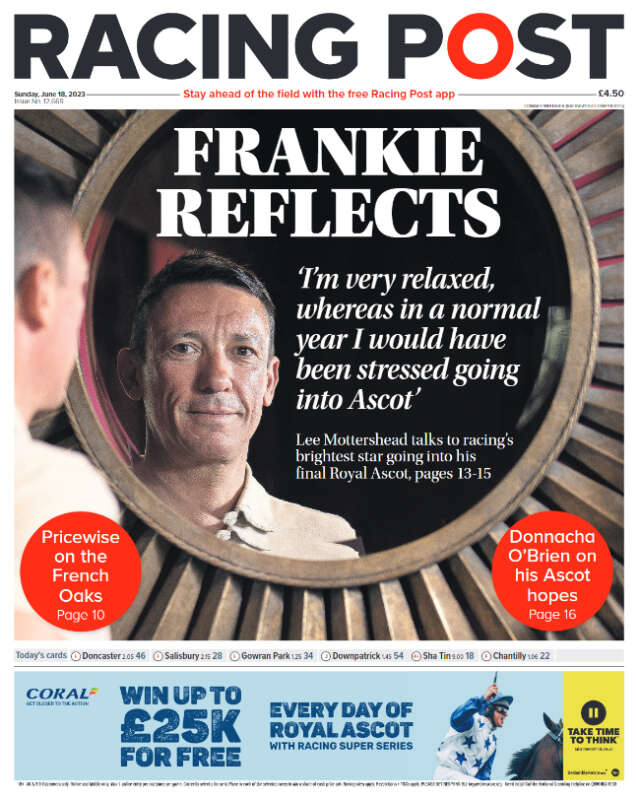
When horse racing stopped in Britain for three months during the first lockdown of 2020, the iconic Racing Post daily newspaper faced arguably the most difficult period in its history: an enforced shutdown caused by the complete cessation of the equine events that provide the lifeblood of the paper.
While some sports managed to continue behind closed doors, UK racing was halted for an open-ended timeframe – a disaster for a title that thrived on reporting and breaking news of events throughout the country each day.
Not only did this remove the source of much of the paper’s content and affiliated income, but it also removed a major distribution pathway to circulation success, which was already hammered by the reduced footfall in newsagents.
The paper’s management and owners – Exponent Private Equity group – were presented with a terrible decision and, as editor Tom Kerr explained, the title was forced into ‘hibernation’, with the print editions halted for the foreseeable future and 89% of staff furloughed during the pandemic.
The remaining digital team doubled down on features, news and insight content, with a determination to show its loyal readers that while the events may have paused, the Post’s ability to bring news on the people and industry of horse racing remained undulled.
Meanwhile, the title itself was reimagining what it could be as a digital proposition in the future. It committed towards a plan of improved sites and apps, with better content and accessibility for when the events restarted – whenever that would be.
When racing returned – at first behind closed doors – there was, as Kerr says, an “extraordinary velocity” behind the digital versions, which include a free version for casual horse-racing fans and a paid version for professionals in the industry.
As Kerr explains: “We saw massive subscriber and audience growth during that period, and it also allowed us to think about how we were structured as a business.”
Now post-pandemic, on the days of large equestrian events, such as the Grand National or Cheltenham Festival, digital visitors to the Racing Post’s sites and apps now top 1.5 million – up from around 300,000 on an average day pre-pandemic, Kerr says.
Online subscribers now number 15,000, up by more than 20% from the pre-2020 numbers.
The title has bounced back with this new focus on digital, and its online revenues are set to outpace the print edition for the first time this year.
Within the Racing Post, digital now accounts for almost 60% of revenue. Across the wider Spotlight Sports Group business – which includes sports betting websites in America and an Australian racing newsletter – digital accounts for 70%.
Across the Spotlight Sports Group, there are 180 full-time editorial staff, including 40–45 ‘traditional’ journalists at the Racing Post who produce editorial content for both digital and print.
There are also specialist teams who handle jobs such as analysing races and producing handicap ratings, with most of the work handled in-house.
An industry icon
Racing Post is Britain’s leading newspaper covering horse racing and greyhound racing. It was founded in 1986 by Sheikh Mohammed Bin Rashid Al Maktoum, the current ruler of Dubai and a keen horseman, with his own stables in the UK.
It was a rival to the venerable Sporting Life newspaper, which began publishing in 1859 before the two publications merged in 1998.
The Racing Post’s top-tier online subscription is £39.95 and the print paper is £4.50 or £4.95 on Saturdays.
Commenting on the paper’s pricing structure, Kerr says: “We know this makes us an expensive newspaper, but we provide a highly specialised service producing a vast range of racing news, insight and data. It’s expensive to do it properly, and we decided long ago that it was far better to ask our customers to pay the price necessary to fund, that than to cut corners and get into the inevitable cycle of decline.”

The Racing Post’s print edition claims a circulation of 50,000, but its digital business model is “quite unusual”, according to Kerr, as it has both a free and a premium model, rather than the free version simply being a taster for the paid one.
“We’re not just trying to get everyone down the funnel into being subscribers,” says Kerr. “We have a very diverse audience: it encapsulates people who may watch the racing on a Saturday and have a few five-pound bets, through to professionals who work within racing and who need our journalism and data for the purposes of doing their job.”
The free version offers accessible, lighter content, whereas the paywalled version offers more in-depth reporting, “almost a bit more like a B2B publisher”, as Kerr describes.
“There are a lot of publishers out there covering racing: the stuff which goes into our free package is the stuff other publications do as well, although we set out to do it better than anyone else,” Kerr explains.
“The stuff that’s behind the paywall, no one else does: it’s in-depth reporting, original reporting, investigations, deep dives, interviews and features that you really can’t get anywhere else.”
The newspaper has broken exclusive stories that have shaken the world of horse racing, including an investigation into a major racehorse owner, Amer Abdulaziz, with the investigation overseen by reporter Peter Scargill.
Kerr says: “Abdulaziz burst onto the racing scene from nowhere in 2017, spending millions of dollars and claiming to be operating the world’s first ‘regulated thoroughbred fund’.
“It subsequently emerged that the money he was spending was alleged to have come from OneCoin, a multi-billion-dollar cryptocurrency scam led by the ‘Missing Cryptoqueen’ of BBC podcast fame and for which it was claimed he was laundering money.”
The Racing Post’s reporting established that OneCoin had been based at an office owned by Abdulaziz and that his ‘regulated fund’ was not operational.
Abdulaziz has subsequently been banned from racing horses in many countries.
A digital approach
Today, the “vast majority” of the business is geared around Racing Post’s digital platforms, with separate print teams taking online content and forming it into print products.
Digital revenues come from subscriptions, advertising and affiliate activity, Kerr says, with a significant B2B operation that supplies racing and sports betting content to publishers and bookmakers.
Before the pandemic, group revenues were 50/50 print and digital, yet the digital ‘bounce back’ since the pandemic has seen online advertising revenue rise by 70% and affiliate activity rise by 20%.
Before 2020, Racing Post had been using two bespoke internal CMSs, which had become expensive to maintain.
In 2020 they migrated to Glide Publishing Platform, a specialised headless CMS for the publishing industry.
“Looking back, you think the pandemic was a traumatic period and it definitely left a few scars,” Kerr says. “But it also allowed us to make a lot of progress, to bring a lot of new customers to our digital products and to our subscriber product. We made a lot of progress in a short period of time.”
Innovations from that time include the ability to integrate racecard data directly into stories – information that is hugely important to the Racing Post’s readers, whether amateur or professional.
“We wanted to remove the barrier between journalism and data and meld them together as much as possible,” explains Kerr. “Racecard results are a massive part of what we do at Racing Post, so if you’re reading a race report, you should be able to see the result on the same page. It shouldn’t be an onward journey, it shouldn’t be a link, it should actually be sitting there.”
Kerr says the interactive racecard widgets “create a far richer experience for our customers”.
Racing Post is currently also working on a new app for subscribers, with an improved offering to audiences. As Kerr describes, “It’s a big challenge in how we present content: how we give both those free and subscriber audiences the best possible experience.”
While Racing Post’s site visits are driven by large events such as the Grand National and Cheltenham, the team is also focusing on a longer-term effort to make racing more accessible.
“We want to make racing more accessible to more people, bringing in new generations and new fans,” Kerr says. “We spend a lot of time thinking about how to make the sport as accessible and engaging as it possibly can be.
“One key challenge is to make race cards instantly accessible to everyone regardless of their knowledge level – because, to the uninitiated, they can look like hieroglyphs,” Kerr notes.
“Can we simplify it without taking anything away? That’s one of the puzzles we are trying to solve.”
As with most publishers, print circulation is steadily declining, but, as Kerr explains, this is less of a problem for Racing Post due to its position within the industry.
He adds: “Our percentage decline compares really well against the wider industry. Racing Post goes to every betting shop in the country as well, which gives us a pretty robust position.
“Digital growth and diversification have more than offset that decline.”
Email pged@pressgazette.co.uk to point out mistakes, provide story tips or send in a letter for publication on our "Letters Page" blog


